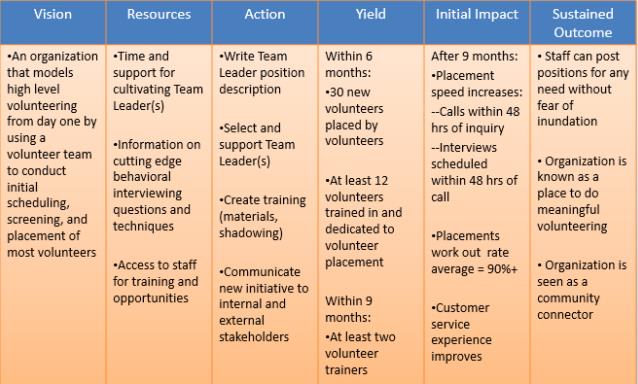Why You Need a Volunteer Work Plan and How to Create One, an Enhancing the Volunteer Lifecycle, Part 3: Engaging Volunteers for Impact & Success Recap
Posted Thursday, June 29th, 2017 by Sterling Volunteers Staff

We recently hosted the third webinar of our three-part series, Enhancing the Volunteer Lifecycle. In Part 3, Engaging Volunteers for Impact & Success, we discussed how to track the impact of your volunteer program beyond counting the number of volunteers and the hours of service they provide.
How do volunteers know when they’ve made a difference, Volunteer Managers? Maybe they’ve spent years mentoring a student and feel a sense of pride when that student graduates high school or makes the Dean’s list. Maybe they help out at the local food pantry unpacking donated goods and are delighted at the end of the day when the shelves are filled with food that will aid families in need. Success in the volunteer community is measured in many different ways. What is vital to keeping volunteers engaged is expressing to them – on a regular basis – the difference they have helped to make through their work with your organization.
That’s where a well-written work plan comes in. A good work plan is like a map that details where you begin, where you’d like to end up, and what resources you have to make the journey a success. Work plans can be written at the organization level, team level, or individual level.
6 Components to an Effective Work Plan:
- Vision –What’s your organization’s mission? What is your ultimate goal when it comes to helping the community? Maybe you want to be the largest food bank in your area, with the ability to help all those who need assistance in accessing healthy food. Decide what your ultimate goal is for your organization, your team or your individual volunteer and write it down here.
- Resources – If you are writing a work plan at the individual level, this is where you would list all the resources that are available for the volunteer in this position to achieve their goal/vision. What funds have the organization set aside towards the project this volunteer is heading? How many volunteers will they have to assist them? Anything along those lines goes here.
- Action – It’s time to get started. At a high level, what are the actions that need to take place in order to achieve your vision? Going back to our food bank example, perhaps you will want to reach out to local grocery stores and other businesses to create a partnership, thereby increasing food and monetary donations – and the ability to feed more families in need.
- Yield – What kind of results do you expect to see? After 3 months how many businesses do you expect to have partnered with? And after 6 months?
- Initial Impact— Everyone has been working hard to help others so let’s see how they did in the initial impact section. Here you’ll list the expected benefits/results of the project. How many families in the community will you be able to assist on a monthly basis? Now’s the time to use numbers and statistics to show the impact your organization will make.
- Sustained Outcome – Here you’ll note the long-term outcome for your organization/team/volunteer. For instance, your organization is now widely known as the go-to food bank within your city.
Here’s an example of a work plan for a Volunteer Placement Team at an organization:
Developing a work plan for your organization, team, and/or volunteers is a helpful way to set goals, outline how you will meet those goals and allow you to know when you’ve been successful. If you don’t currently take this step, we encourage you to try it!

Did you miss the webinar? Check out Engaging Volunteers for Impact & Success on-demand.
Does your organization use work plans to create helpful, detailed roadmaps to incredible results? We would like to hear your ideas! Connect with us on Facebook, Twitter, Linkedin, and share your comments below.
